“GOOD OLD-FASHIONED ENTERTAINMENT”
“A FUN FILM, CONSTRUCTED IN A SMART WAY”
“A DELIGHTFUL (FOUR-STAR) RAPID-FIRE ROMP”
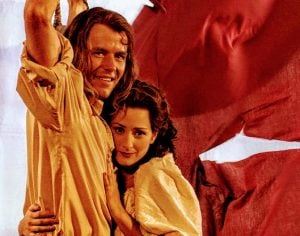
— Tim
No, not that Supreme Court Justice. The justice being sought from the Supreme Court in the just-filed ODH v. FX.
pagesix-com.cdn.ampproject.org…
P.S. I’m not sure all the justices will be able to keep up with our Lady O.
— Tim
EIGHTY YEARS AGO THIS WEEK – OCTOBER 1938
Los Angeles Examiner – Louella Parsons, October 4, 1938
Errol Flynn heard yesterday for the first time that he had pneumonia when he was so critically ill last week. So remarkable was his recovery that he is expected to go home today, and Lili Damita will sail Thursday on the Queen Mary. Errol’s doctors have ordered him to rest for two weeks, after which he is to report to Warner studio for Dodge City.
Don’t say “That’s where we came in,” for Hal Wallis really tried to borrow Ronald Coleman and Cary Grant for the remittance man who goes western. But when neither English accent was available, he went back to the original idea of putting Flynn in the role, postponing The Sea Hawk until early next year. Michael Curtiz, the director, who always favored Flynn, was rejoicing yesterday, for both Flynn and Olivia de Havilland were in Robin Hood Curtiz’ biggest hit.
Dodge City could-have-been cowboys, Coleman and Cary:
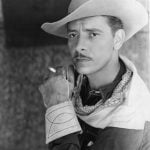
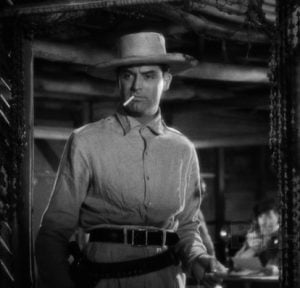
— — —
Los Angeles Evening Herald Express – Harrison Carroll
October 5, 1938
Errol Flynn went from the hospital to Edmund Goulding’s house at Palm Springs. He wanted to take a trip to Mexico City, but doctors vetoed it.
movielanddirectory.com…
— — —
Los Angeles Evening Herald Express – Jimmy Starr
October 10, 1938
Lili Damita shushed those Paris divorce rumors by nixing her trip to Gay Paree with the Jack Warners and flying back to hubby Errol Flynn in Palm Springs.
Here they are in Palm Springs:
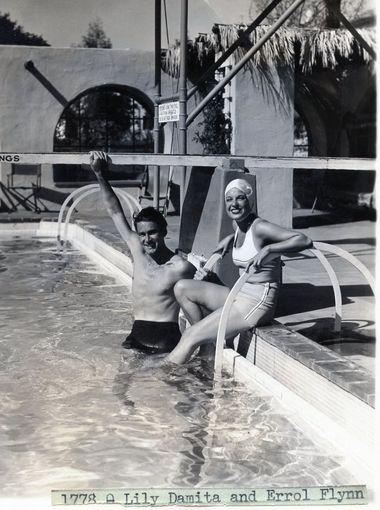
— Tim
Flynn and Custer, a perfect match – brilliant, discipline-proof, dashing, and destined for greatness.
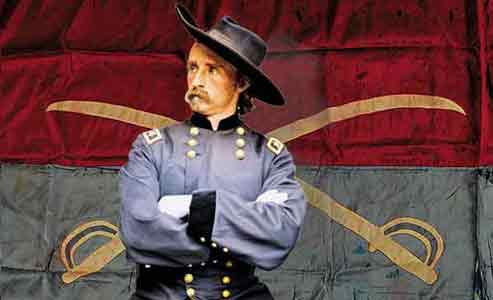
THEY DIED WITH THEIR BOOTS ON
(Benton Harbor News-Palladium, December 29, 1941.)
Monroe- The premier of the motion picture “They Died With Their Boots On” depicting the career of General George Armstrong Custer, was shown here Sunday. Seven members of the Custer family residing here attended the performance. Brigadier-General Custer, slain in the Battle of the Little Big Horn, attended school and married here.
ERROL FLYNN PLAYS GEORGE CUSTER
(Benton Harbor News-Palladium, January 10, 1942)
Custer’s last stand is an epic of the old west, but the rest of Custer’s life is a Michigan story. As shown in They Died With Their Boots On, the new Errol Flynn, Olivia de Havilland film opening Sunday at the Liberty, George Armstrong Custer’s adventures were intimately concerned with his native state.
He made a name for himself in the Civil War at the Battle of Gettysburg depicted in the film by leading a series of charges by gallant Michigan regiments. Thrown back time and time again, they kept up the fight under his inspirational leadership and finally turned the tide of battle.
After the Civil War ended, Custer like so many brilliant young officers of the Union Army, was retired. A peacetime Army had no use for the vast number of officers developed by the war. Young General Custer settled down with his wife in their native Monroe, Michigan, to live a life of peace.
It was from the same Monroe that Custer had gone before the Civil War to become the most discipline-proof cadet that West Point had seen in years.
According to the film, the most famous song of Custer’s Seventh Regiment, the Gary Owen, was taught to the General in Monroe by an English soldier who was a Union veteran. When the regiment rode forth in battle on the Little Big Horn, the song Custer learned in Monroe, sped them on their way.
George Custer was only 37 when he died. Life in Monroe had bored him. In order to get back into active Army service, he accepted colonel’s rank. He was sent to the most dangerous territory in America, Sioux Country. The Indians called him “Long Hair.” The tribute they paid him in his last stand shows the esteem in which he was held, even by his enemies. Every man killed in the battle was scalped – except Custer.
GENERAL CUSTER AFYER 45 YEARS
(Detroit Free Press, June 27, 1921)
It has been remarked that George Armstrong Custer’s chief contribution to the history of his country was his personality. Such a statement looks like a truism, but in his case it was more peculiarly true than in most. An operose, impetuous spirit, his tepidity, his dash, his verve, has passed into legend while there are still people living in these states who thrill to the memory of the day when Custer fell, who remember the clash of opinion that arose before his gallant blood had cooled.
The forty-five years that have passed since June 25, 1876, have not settled the argument. Was Custer’s death with his three brothers, his nephew, and all of the old fighting Seventh Michigan Cavalry , due to mis-wisdom, an untutored impetuosity, or were the trap and the barbarous slaying inevitable? How much of the mistake can be placed on the two commanders under him, Benteen and Reno, and was the natural indignation of the country justified? The exact facts are obscure, for we are unwilling to accept the only evidence which came from an Indian.
The significant thing now is that Custer’s story is not allowed to die – it is too romantic, too fraught with the perilous spirit of the frontier days which have rapidly dimmed and receded. The story has been woven into pageants, it has been vividly acted before the camera in its own historic setting. Today, out in Hardin, Montana, it is being commemorated again, re-enacted with Indians, some of whom are from the fierce tribe of Sitting Bull. Tamed now and submissive, forgetting the hot rage of the warrior, they are acting for the pleasure of the conqueror and perhaps for the lost glory of their tribe, scenes which were part of the destructive tide that swept them from their last entrenchments in the badlands of the prairie.
What history will do with Custer a hundred years, hence it is impossible to judge; it is probably that no matter what the historian of the future makes of his case he will be handed along in the legends which gave the thrill to cold facts as the perfect cavalry type, the temerarious General of Horse. The nation will remember him as Edward Clark Potter has pictured him when in that significant moment during a lull in the Battle of the Little Big Horn, he spurred forward from the line, and hat in hand, his golden curls flowing from a head thrown back, he stood for a moment surveying enemy lines. His striking uniform, his youth, his daring, combined to make him a glorious, a charmed figure.
The nation will remember him too, however much they may doubt his judgment, as the general who immensely brave, immensely daring, overpowered twenty to one, stayed with his men and died fighting in place. They will honor him as the Sioux honored him, Sitting Bull’s warriors who killed him but held his body inviolate because he was a warrior of whose prowess they stood in awe.
CUSTER’S LAST GUIDON
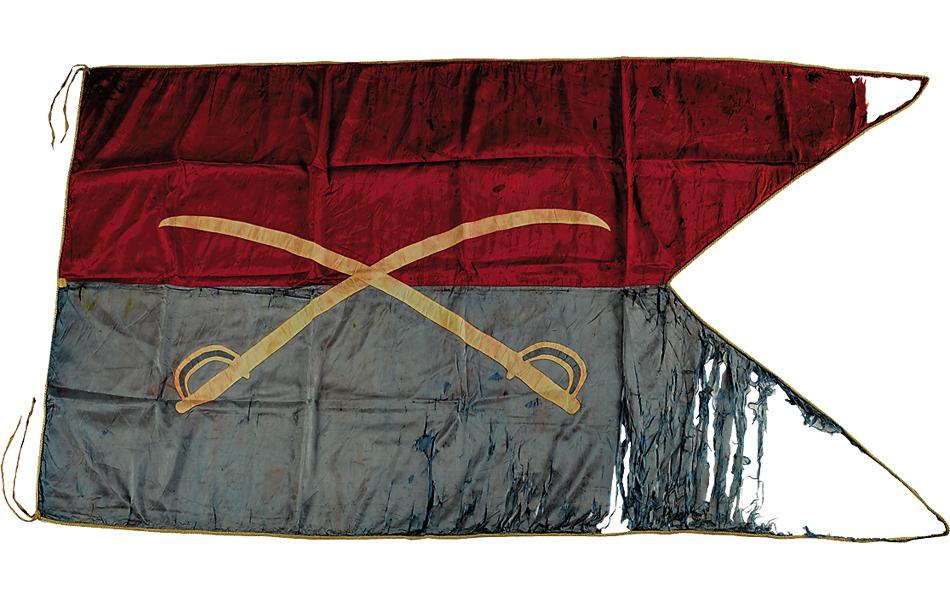
— Tim
Was Albert Einstein one of Errol’s amazing universe of friends? Absolutely, relates this relatively unknown account. Is this just Hollywood spin? An unproven theory?
Periodically, Einstein did circulate with a cluster of mega-stars from LA LA Land. But, in the orbit of Errol? For the reasons postulated? Improbable perhaps, but, as with all things Flynn, not astronomically impossible. Here’s A.E. with J.W., four years before Errol arrived from another world:
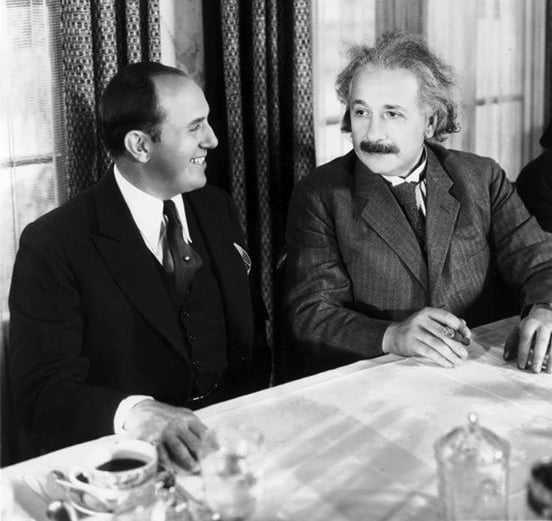
And he was a high-flying star in a film at Warner Brothers …
— Tim